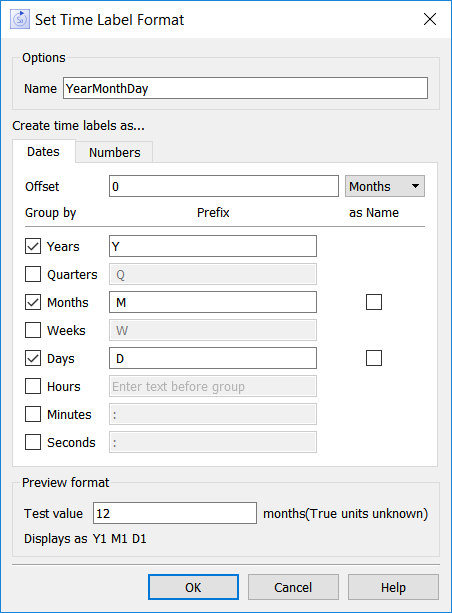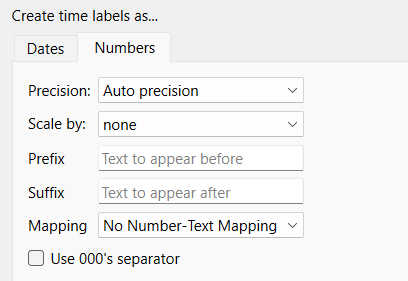
Use the time label format dialog to edit time label formats. It is opened from the Manage Time Labels dialog box, which itself is opened from the Model Settings Properties Panel.

Name is the name to be referenced when assigning the format. Any name will do, but one that reminds you of the content of the type of formatting chosen can be helpful. If this name is empty, or not unique, then the OK button will be disabled.
There are two types of time labels that can be created. The first type is a generalized date format that allows you to break up time into different components such as years, months, and days. The second is simply a number, for which you can set precision and scaling.
Format specifies the appearance of the time label being presented. It contains a number of commonly used formats as well as an option for a custom format. The dropdown shows short labels related to the format and an example of that the format would look like for (usually) December 17, 2023.
Format String specifies the actual format based on a number of substitution placeholders enclosed in ${}. The full set of possible placeholders and their meaning is described below. You can type into the format string at any time. As you start typing the format will change to Custom. It is easiest to pick a format close to what you want, then edit it.
When TIME in the model is specifies the model time that will be used to create the base date for the label. By default this is Start Time as specified in Model Settings Properties Panel.
the date will be January 1, specifies the year associated with the above time. The default is 2020. The date will be December 31 if the End of year checkbox is selected. With models in hours, minutes, or seconds, the default is 0 instead of 2020 and the formatting will be configured to count hours and days from time 0 not just show the hour of the day or the day of the month as is described below.
End of year, if checked, will associate the starting time specified with December 31 of the year specified. This will also treat values on even months as the last day in the month (28, 29, 30, or 31), and values in the middle of the month as the 15th.
Numbers uses the same format options as scales for variables, though using prefixes and 000s separators are not likely to be useful.


Type in the model time value you would like to preview. Displays as will show how that value will be displayed.
The format string is composed of text and substitutions enclosed in ${}. For example
The year is ${yyyy}
would display
The year is 2020
Format strings are not case sensitive. They are shown here in lower case, but you can also use upper case to have the same effect. The following format strings are available:
${ap} will show either AM or PM depending on the hour of the day.
${d} will show the day of the month (1-31).
${dd} will show the day of the month always using 2 digits (01-31).
${ddd} will show the weekday using the 3 letter short form (Sun, Mon, Tue, Wed, Thu, Fri, Sat).
${dddd} will show the weekday using full day names (Sunday, Monday...).
${dy} will show the day of the year (1-365 or 366). When the value for date is set to 0, this will count days since the specified start time.
${h12} will show the hour of the day (1-12) using a 12 hour clock.
${h24} will show the hour of the day using a 24 hour clock (0-23).
${hh12} will show the hour of the day with 2 digits (01-12) using a 12 hour clock.
${hh24} will show the hour of the day with 2 digits using a 24 hour clock (00-23).
${hy} will show the hour of the year (0-8760). When the value for date is set to 0, this will count hours since the specified start time.
${m} will show the month of the year (1-12).
${mm} will show the month of the year with 2 digits (01-12).
${mmm} will show the month of the year as a short name (Jan, Feb, ...)
${mmmm} will show the month of the year as a complete name (January, February, ...).
${mmmmm} will show the first letter of the month of the year (J,F,M,A,M,J,J,A,S,O,N,D);
${mq} will show the month of the quarter (1-3).
${n} will show the number of minutes in the hour (0-59).
${nn} will show the number of minutes in the hour with 2 digits (00-59).
${q} will show the quarter of the year (1-4).
${s} will show the number of seconds in the minute (0-59).
${ss} will show the number of seconds in the minute with 2 digits (00-59).
${w} will show the week of the month (1-5).
${wy} will show the week of the year (1-53). When the value of date is set to 0 this will count weeks from the start time.
${y} will show the year as a number. For initial dates bigger than 100 this is the same as ${yyyy}.
${yy} will show the year as 2 digits (e.g. both 1922 and 2022 would be just 22).
${yyyy} will show the 4 digit year. Though for years beyond 9999 it will just show the year.